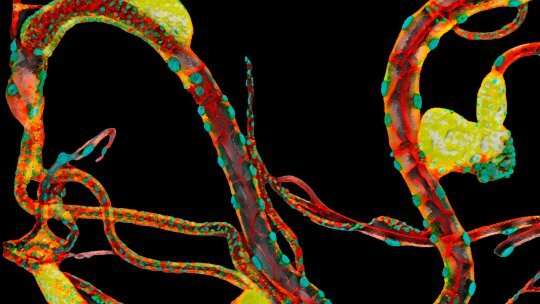This article has been reviewed according to Science X's editorial process and policies. Editors have highlighted the following attributes while ensuring the content's credibility:
fact-checked
trusted source
proofread
Number of DNA copies influences the cell death process that shapes organs during embryonic development: Study

During embryonic development, the programmed death of certain cells plays an essential role in shaping organs and allowing proper growth. This cell death is in some cases an effect of autophagy, a key cellular process responsible for the degradation and recycling of damaged or unwanted cellular components and which, taken to the extreme, may end up eliminating the cell itself.
Led by Dr. Jordi Casanova and Dr. Panagiotis Giannios, a team of researchers at IRB Barcelona and IBMB(CSIC) has revealed the relationship between autophagy and polyploidy, the latter a phenomenon in which cells contain multiple copies of genetic material. In this regard, they have discovered a scenario where the level of autophagy is much higher in cells with several copies of DNA and that it can even trigger this programmed cell death.
Published in the journal Autophagy, this finding sheds light on the biological processes that shape organisms during the early stages of life, and it paves the way to a better understanding of developmental diseases and also cancer.
"Polyploidy is a common phenomenon in many species, including humans, and understanding its implications for embryonic development could have a significant impact on medicine," explains Dr. Casanova, head of the Development and Morphogenesis in Drosophila lab at IRB Barcelona.
Progenitor cells and polyploidy
Progenitor cells can give rise to different cell types. In the case of the Drosophila melanogaster fly, the animal model used in this study, the progenitor cells are larval cells that conserve the capacity to give rise to the adult organism. These cells do not present polyploidy (they have a single copy of the set of chromosomes) and this allows them to survive metamorphosis and form part of the adult.
"In the case of cancer, it is common for cells to have several copies of DNA (polyploidy), and this property might confer increased resistance, for example, to chemotherapy treatment. This is why it is important to understand this process," adds Dr. Giannios, a postdoctoral researcher in the same laboratory.
Polyploidy in the trachea of the fruit fly
To study this process, the researchers worked with the trachea of the D. melanogaster fly as a model, which presents a variety of cells of the same type, some with polyploidy and others without.
"Working with the trachea of the Drosophila fly has allowed us to compare cells of the same type, some presenting polyploidy and others not, and to see how polyploidy correlates with cell death during metamorphosis," explains Dr. Beatriz Pino-Jiménez, first author of the work, who carried out this project as part of her doctoral studies.
The research team is now working to determine whether polyploid cells respond better to stress situations and, if so, what the mechanisms underlying this response are.
More information: Beatriz Pino-Jiménez et al, Polyploidy-associated autophagy promotes larval tracheal histolysis at Drosophila metamorphosis, Autophagy (2023). DOI: 10.1080/15548627.2023.2231828




















